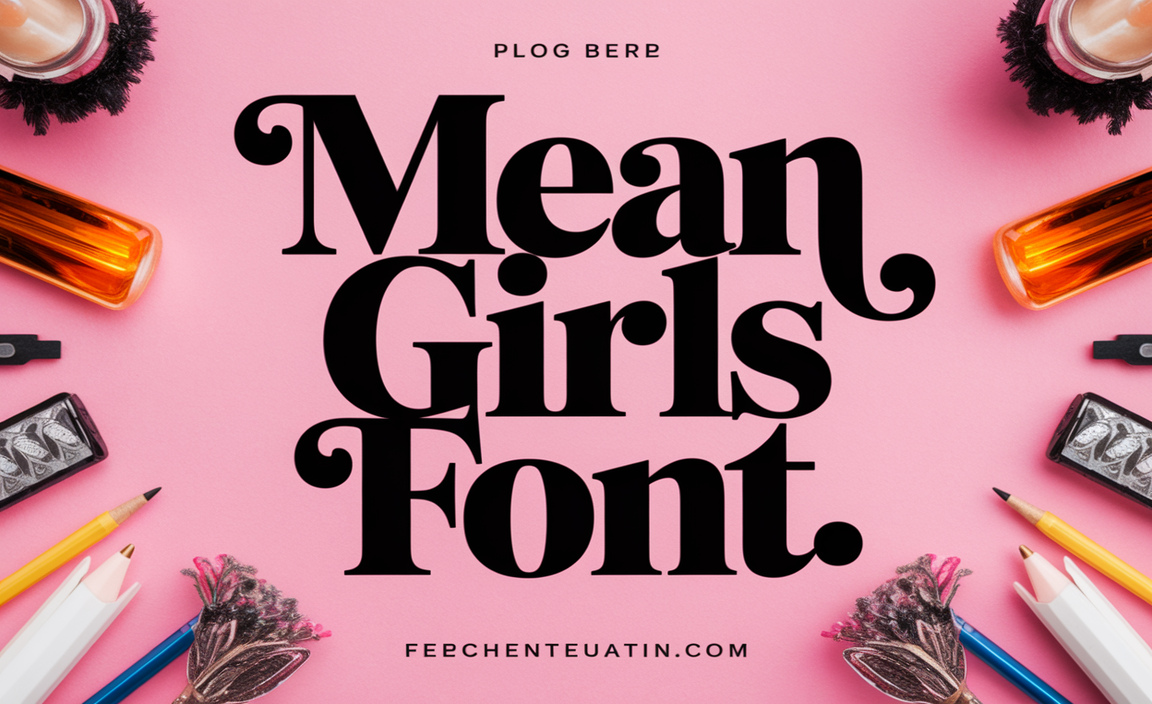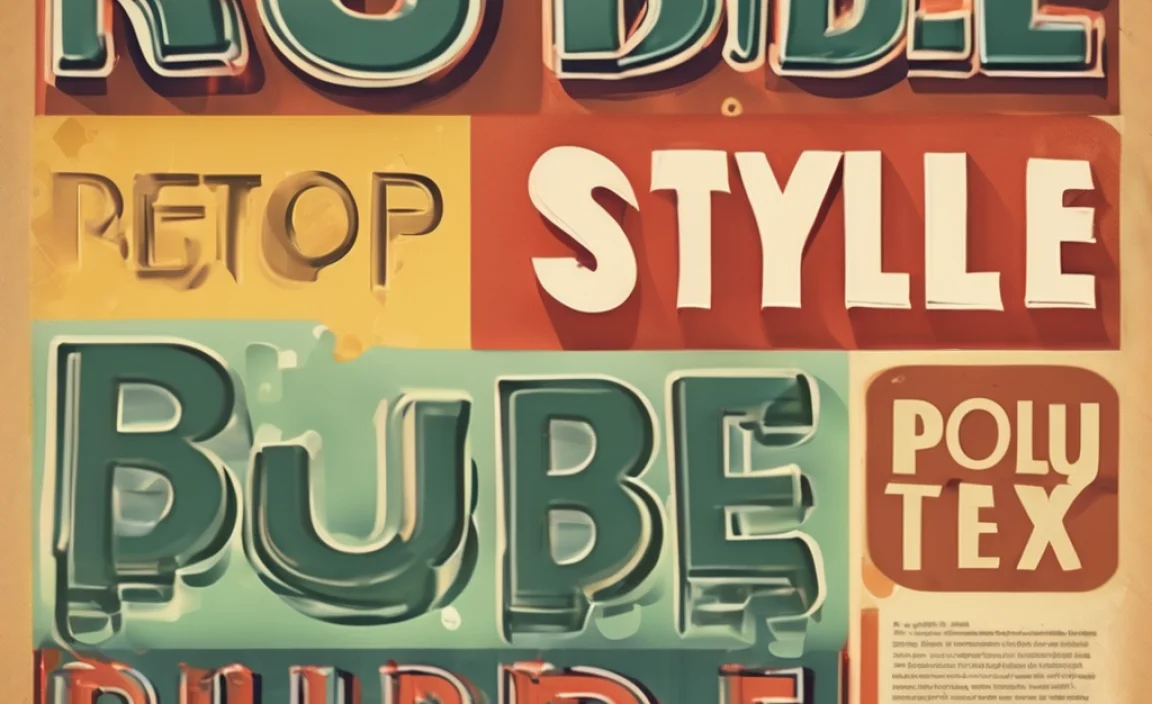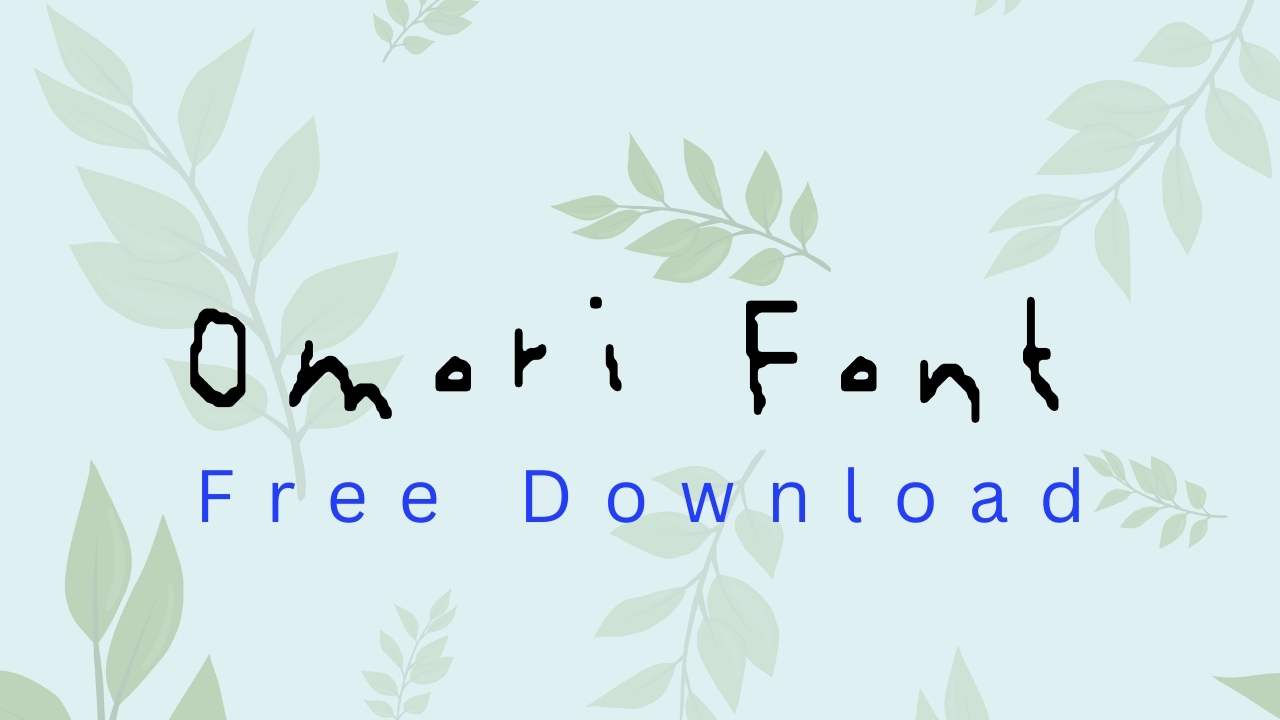Quick Summary:
Botanical fonts bring nature’s intricate beauty to your designs. Mastering their use involves understanding their organic feel, balancing them with other typefaces, and applying them thoughtfully for legibility and aesthetic appeal. These fonts add a unique, natural charm, perfect for projects seeking an earthy or whimsical touch.
Ever looked at a beautiful design and wondered what makes it feel so alive and natural? Often, it’s the magic of a botanical font! These unique typefaces capture the elegance of leaves, flowers, and vines, adding a touch of the outdoors to your projects. But using them can sometimes feel a bit tricky. Don’t worry, though! With a few simple tips, you can make botanical fonts shine in your designs. We’ll explore how to choose them, pair them, and make them work beautifully. Get ready to bring a breath of fresh air to your creative work as we dive into making botanical font letters truly stunning!
The Allure of Botanical Fonts: Why They Captivate
Botanical fonts are more than just letters; they’re miniature works of art inspired by the natural world. Think delicate stems wrapping around a letter, a subtle leaf emerging from a curve, or swirling vine-like flourishes. They evoke feelings of growth, tranquility, and organic beauty. This connection to nature makes them incredibly versatile, perfect for everything from wedding invitations and branding for eco-friendly businesses to children’s books and artisanal product packaging.
Their appeal lies in their ability to add personality and a distinct mood to a design. Unlike standard fonts, botanical designs offer a visual story, hinting at nature’s intricate patterns and graceful forms. This makes them a powerful tool for designers looking to create something memorable and emotionally resonant. When used correctly, they can transform a simple piece of text into an enchanting visual element.
The trend towards sustainability and a return to nature in design further highlights the popularity of botanical fonts. They resonate with audiences seeking authenticity and a connection to the earth. As designer Beatrice Warde famously said, “typography is a tool for transmitting information, not a design in itself.” Botanical fonts, however, blur this line beautifully, acting as both informative and decorative elements.
Understanding the “Botanical” In Botanical Fonts
What exactly makes a font “botanical”? It’s the subtle (or not-so-subtle) incorporation of natural elements into the letterforms themselves or in decorative flourishes. These elements can include:
- Leaf Motifs: Small leaves integrated into serifs, terminals, or as decorative elements.
- Floral Accents: Delicate flower buds, petals, or full blooms adorning letters or acting as swashes.
- Vining Tendrils: Elegant, twisting stems that can extend from letters or connect words.
- Organic Curves: Letter shapes that mimic the natural, flowing lines found in plants, often with an irregular, hand-drawn feel.
- Textural Details: Some fonts might incorporate subtle textures reminiscent of bark or delicate plant surfaces.
These fonts often lean towards decorative or display categories, meaning they are best used for headings, short phrases, or accents rather than long blocks of body text. Their intricate details can sometimes impact readability in smaller sizes.
Essential Tips for Using Botanical Font Letters Effectively
Now that we appreciate their charm, let’s explore how to make them work for you. Here’s how to harness the power of the botanical font letter effectively:
1. Choose Wisely: Match the Mood and Purpose
Not all botanical fonts are created equal. Some are delicate and ethereal, while others are bold and whimsical. Consider the overall feeling you want to convey:
- Ethereal & Romantic: Look for fonts with fine lines, delicate flowers, and graceful vine elements. Perfect for wedding invitations, love poems, or spa branding.
- Whimsical & Playful: Opt for fonts with more pronounced, stylized leaves and berries, perhaps with a hand-drawn quality. Great for children’s brands, craft blogs, or quirky event invitations.
- Elegant & Sophisticated: Subtle botanical touches integrated into classic serif or sans-serif structures can offer a refined look. Ideal for luxury brands, editorial design, or high-end product packaging.
- Rustic & Earthy: Fonts with a more organic, slightly rough texture and less ornate floral elements can convey a grounded, natural feel. Suited for organic produce brands, nature retreats, or artisan bakeries.
Before committing, download sample characters. See how the “Botanical Font Letter” itself looks. Does it have the detail you need? Does it feel balanced? Experimenting with a few options is key.
2. Prioritize Readability: Less is Often More
Botanical fonts are often highly decorative. This means they can be challenging to read in large blocks of text or small sizes. Remember that clear communication is paramount. Therefore, these fonts typically function best as:
- Headings and Titles: Their decorative nature makes them perfect for grabbing attention and setting the tone for a page or section.
- Accents and Embellishments: Use them for short, impactful phrases, logos, or call-to-action buttons where their style can shine without hindering understanding.
- Logotypes: For brands that want to strongly associate themselves with nature, a custom logotype using a botanical font can be very effective.
If you need to use a botanical font for a slightly longer phrase, ensure there’s ample spacing between letters (kerning) and lines (leading) to prevent clutter. A good rule of thumb from the folks at the Graphic Design Institute emphasizes that “legibility should never be sacrificed for style.”
3. The Art of Pairing: Finding the Perfect Companion
Botanical fonts rarely stand alone. To create a balanced and professional design, you need to pair them with complementary typefaces. The goal is to let the botanical font be the star while ensuring the rest of your text is readable and harmonious.
Good Pairing Strategies:
- Classic Sans-Serif: Clean, uncomplicated sans-serif fonts like Open Sans, Lato, or Montserrat provide a neutral backdrop that allows the botanical details to pop. They offer excellent readability for body copy.
- Simple Serif: A straightforward serif font, such as Merriweather or Georgia, can add a touch of traditional elegance without competing with the botanical elements.
- Minimalist Script Fonts: If your botanical font is subtle, a very clean, understated script font can sometimes work, but be cautious not to overload the design with decorative styles.
Avoid pairing a highly decorative botanical font with another ornate font, as this can lead to visual chaos. Stick to fonts with clean lines and simple forms for supporting text.
Pairing Table Example:
| Botanical Font Style | Ideal Pairings (for body text/supporting elements) | Why it Works |
|---|---|---|
| Delicate & Ethereal Florals | Avenir Light, Lato Light, Raleway (Light/Regular) | Clean, neutral sans-serifs complement the fine details without overwhelming them. |
| Whimsical & Playful Leaves | Montserrat (Regular), Roboto (Regular), Open Sans (Semibold) | Modern, friendly sans-serifs match the playful vibe and ensure readability. |
| Elegant & Subtle Vines | Merriweather (Regular), Source Serif Pro (Regular), EB Garamond | Classic serifs provide a sophisticated counterpoint, enhancing the overall refined feel. |
| Rustic Barn & Bud Motifs | Arvo (Regular), PT Serif (Regular), Noto Serif | Sturdy, legible serifs with a slightly traditional feel ground the design and add readability. |
4. Leverage Ligatures and Alternates
Many sophisticated botanical fonts come with OpenType features like ligatures and alternate glyphs. A ligature is a single character that combines two or more letters (e.g., ‘fi’, ‘fl’). Alternate glyphs offer different stylistic versions of letters.
For example, a botanical font might have:
- Decorative Ligatures: A ligature where the combined letters are connected by a vine.
- Extended Swashes: Alternate starting or ending characters for letters that have long, flowing flourishes, allowing you to extend them.
- Leafy Flourishes: Specific alternate characters for letters like ‘T’, ‘L’, or ‘S’ that include prominent leaf or vine elements.
Exploring and using these features can add unique flair and a polished look to your design. Check your design software’s glyph panel or OpenType features to see what’s available. This is where the “Botanical Font Letter” truly comes to life with unique stylistic options.
5. Consider Color and Contrast
The color palette you choose will significantly impact how your botanical font reads. Since these fonts often have intricate details, ensuring good contrast is crucial.
- Against Light Backgrounds: Deep greens, rich browns, or even a dark, elegant grey can make botanical elements stand out beautifully on white or cream backgrounds.
- Against Dark Backgrounds: Lighter, desaturated greens, earthy beiges, or even a metallic gold or silver can create a striking contrast on dark backgrounds.
- Subtle Tones: For a very soft, organic look, consider using colors found in nature – muted greens, terracotta, dusty rose, or pale blues.
Be mindful of accessibility standards. Ensure sufficient contrast ratios (at least 4.5:1 for normal text and 3:1 for large text) to make your design readable for everyone. Resources from the Web Content Accessibility Guidelines (WCAG) can provide valuable insights here.
6. Spacing is Key: Kerning and Leading Matter
The intricate details of botanical fonts can sometimes make them appear to clump together, or conversely, create awkward gaps. This is where careful attention to spacing becomes vital.
- Kerning: Adjust the space between individual letter pairs. For botanical fonts, you might need to slightly tighten the space between letters with flourishes or widen the space if they feel too crowded. Pay special attention to pairs where elements overlap or run close to each other.
- Leading: Adjust the space between lines of text. If using botanical fonts for headings or short phrases that sit above each other, ensure there’s enough vertical space so the decorative elements don’t collide.
- Tracking: Adjust the overall spacing of a block of text. For display purposes, a slightly looser tracking can sometimes improve the airiness and legibility of decorative fonts.
Take the time to manually kern and adjust leading, especially for your most important text elements. This small effort makes a big difference in refinement.
7. Use Sparingly, But Impactfully
The power of a decorative font, including botanical ones, lies in its ability to draw attention. Overusing it dilutes its impact and can make a design feel cluttered or unprofessional.
Think of it like a spice: a little adds wonderful flavor, but too much can overwhelm the dish. Use your botanical font for its intended purpose – to be a highlight.
- Single-Word Emphasis: A single word like “Welcome,” “Love,” or “Nature” in a botanical font can be incredibly impactful.
- Logo Design: As mentioned, perfect for brand identity.
- Quote Graphics: A beautiful quote rendered in a botanical font can be a shareable piece of art for social media.
- Decorative Elements: Sometimes, a single letter or a short word can act as a beautiful graphic embellishment within a larger design.
8. Context is Everything: Where to Use Them
Consider the platform and the audience you’re designing for. Botanical fonts are excellent for:
- Print Design: Invitations, greeting cards, packaging, book covers, flyers for events.
- Digital Design: Website headers, feature images, social media graphics, artisanal product listings.
- Personal Projects: Creative journaling, handmade crafts, personal stationery.
Be mindful of web font licenses if you’re using them for websites. Ensure you have the appropriate license for web use, which can sometimes differ from desktop use. Font foundries like Google Fonts offer many free, high-quality options, while others like Fontspring or MyFonts offer purchasable licenses.
Examples of Botanical Font Letters in Action
Let’s visualize how these tips translate into real-world applications:
- Wedding Invitation: The couple’s names (“Anna & Tom”) rendered in an elegant botanical script, with supporting details (date, venue) in a clean sans-serif like Raleway. The overall invitation card features subtle floral watercolor backgrounds.
- Organic Skincare Brand Logo: The brand name “Veridian Botanics” uses a botanical font where the ‘V’ has a delicate vine extending from its stem, and the ‘o’ in ‘Botanics’ is subtly shaped like a budding flower. The tagline below is in a simple, readable serif like PT Serif.
- Blog Post Title: A blog post titled “The Secret Garden” uses a whimsical botanical font for the title, with a small illustrated butterfly or leaf integrated near the “S” or “G”. The body of the post uses a highly legible font like Open Sans for ease of reading on screen.
These examples show how the botanical font letter section leads the visual narrative, while other fonts ensure clear communication.
Where to Find Wonderful Botanical Fonts
There are many places to discover these nature-inspired treasures. Here are a few popular options:
- Google Fonts: Offers a curated selection of free fonts. While not always explicitly “botanical,” you can find fonts with organic shapes or decorative serifs that evoke nature. Search terms like “script,” “display,” or “decorative” can yield good results.
- Adobe Fonts: Included with Adobe Creative Cloud subscriptions, this library has a vast collection, including many beautiful display and script fonts that can suit a botanical theme.
- Creative Market & Envato Elements: These marketplaces offer a wide variety of premium fonts, often featuring unique and specialized styles like botanical designs. You can purchase individual fonts or access them through subscription services.
- Specific Font Foundries: Many independent font designers and foundries specialize in decorative and unique typefaces. Exploring sites like Fontspring, MyFonts, or even individual designer portfolios can lead to hidden gems.
When browsing, look for descriptions that mention “organic,” “floral,” “natural,” or “whimsical.” Previewing the full character set is always recommended.
Frequently Asked Questions (FAQ)
What is the best way to use a botanical font for body text?
It’s generally not recommended to use botanical fonts for extended body text. Their decorative nature can make them hard to read in paragraphs. They are best used for headings, titles, or short, impactful phrases.
Are botanical fonts good for logos?
Yes, botanical fonts can be excellent for logos, especially for brands associated with nature, wellness, beauty, or artisanal products. They help convey a specific mood and identity. However, ensure the logo remains legible at various sizes, especially very small ones.
How do I make sure my botanical font pairing is readable?
Choose a clean, simple, and highly legible sans-serif or serif font to pair with your botanical font. The supporting font should be neutral and unobtrusive, allowing the botanical typeface to be the visual highlight while ensuring the message is clear.
Can I use botanical fonts on a website?
Absolutely! Many botanical fonts are available as web fonts. You’ll need to ensure you have the correct web font license from the foundry. Just remember the readability tips – use them for headings and short text elements, not for the entire website content.
What’s the difference between a botanical font and a floral font?
The terms are often used interchangeably. “Botanical” might imply a broader range of plant life (leaves, vines, stems), while “floral” might focus more specifically on flowers. However, both aim to capture the essence of nature’s beauty in typography.
How can I adjust the spacing of a botanical font letter?
You can adjust spacing using kerning (space between specific letter pairs), tracking (overall spacing for a block of text), and leading (space between lines). Most design software allows these adjustments. For botanical fonts, you might need to tweak spacing more than for standard fonts to ensure legibility and prevent visual clutter.
Are all botanical fonts difficult to read?
Not all. Some botanical fonts are designed with more subtle elements, making them more readable than others. However, as a general rule, the more intricate the decorative elements (leaves, flowers, vines), the less suitable the font is for long passages of text. Always test readability in your intended context and size.
Conclusion: Cultivating Stunning Designs with Botanical Fonts
Botanical fonts offer a unique and enchanting way to infuse your designs with the beauty and tranquility of nature. By understanding their strengths, choosing them thoughtfully









